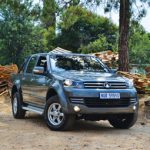The thrills and spills of Dakar 2015

GIANENRICO GRIFFINI brings us an exclusive interview with Ayrat Mardeev of the Kamaz Master Team, winners of Dakar 2015.
Three Kamaz pilots on the podium and another Kamaz truck in fifth position in the final ranking. Did you expect this result before the last Dakar?
We worked hard to get good results, but no one imagined that we will have three places. We never try to predict events. The most important thing for us is stable driving.
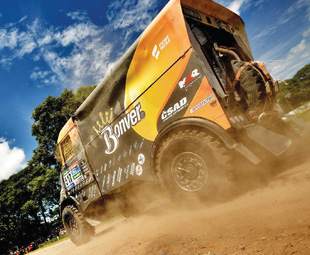 What are the reasons for this stellar performance? Is it mainly due to the trucks, the team, the tactic of your team manager Vladimir Chagin, or the reliable Liebherr engines?
What are the reasons for this stellar performance? Is it mainly due to the trucks, the team, the tactic of your team manager Vladimir Chagin, or the reliable Liebherr engines?
All these factors are very important. First, we are a team. We work together as a harmonious mechanism; our work is well coordinated. We work for a common goal and not for an individual result. The second reason is very good preparation of the trucks, but again, this is thanks to the team – specifically our mechanics and engineers.
We also have a very nice, fast truck. We’ve used new Liebherr engines to comply with Dakar regulations. We do not have much experience with these engines, but all the improvements and modifications that have been made by our engineers show that we are moving in the right direction.
I should also note “the Chagin factor” in our success. His experience and advice are crucial.
Tell us the story of your Dakar this year. Was it easier or more difficult than the 2014 rally? What were the most difficult and demanding stages?
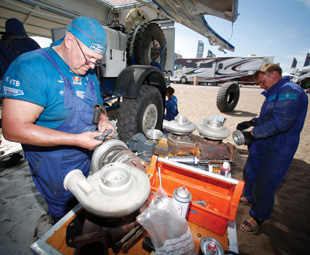 I remember a marathon stage that we drove for the first time. Eduard Nikolaev and I already had experience of stages such as this from when we were crew mechanics. It was important not to break the car and still show good results, as we had no help from our assistance crews that day.
I remember a marathon stage that we drove for the first time. Eduard Nikolaev and I already had experience of stages such as this from when we were crew mechanics. It was important not to break the car and still show good results, as we had no help from our assistance crews that day.
Dakar is always very difficult. The most difficult part this year was the special stage in the mountains, when we rose in height. The special stage started at an altitude of 3 500 m and we rose up to 4 500 m. Breaking the engine was a big risk, so we had to check all the parameters even more carefully. It didn’t affect our physical state, as we trained a lot before the rally.
The pace of this year’s rally surprised me. From the very beginning the first 15 trucks drove within five minutes of each other. So any navigation mistake or breakdown throws you off at the end, and then it becomes difficult to win back lost time. We didn’t expect such high-speed special stages, where the average speed of the truck was 110 km/h – it is a furious pace for a truck, as the maximum permitted speed for trucks is 140 km/h. It was unusual.
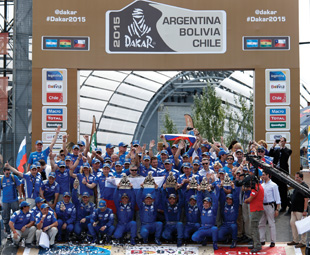 Dakar 2015 became the fastest rally, no matter whether we were off-road or not. The difficulty was that the front cars raised clouds of dust. It was particularly difficult where it was not possible to overtake for better visibility. Only the vehicle that took the lead could win at such stages. The race was very unpredictable. The realisation that we were the winners came to me only when I was standing on the podium in Buenos Aires.
Dakar 2015 became the fastest rally, no matter whether we were off-road or not. The difficulty was that the front cars raised clouds of dust. It was particularly difficult where it was not possible to overtake for better visibility. Only the vehicle that took the lead could win at such stages. The race was very unpredictable. The realisation that we were the winners came to me only when I was standing on the podium in Buenos Aires.
The big technical issue for Kamaz trucks this year was the Liebherr engine. How do you judge its performance? Were you forced to adapt your driving style to the new powertrain?
It is the second time we’ve used the Liebherr engine in the rally. The most difficult thing in the beginning was to get used to the absence of the engine sound, as the Liebherr engine is not audible in the cabin. It is very dynamic, and we were happy with its technical characteristics. We had no technical problems with the engine. Once again, I would like to thank the engineers in our team for the excellent revision of engine parameters.
Who among your competitors were the most challenging?
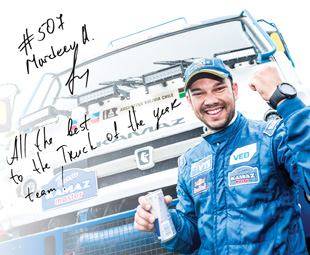 We are very respectful of all our competitors. Gerard De Rooy from Iveco and Ales Loprais from MAN are very fast drivers and dangerous rivals. Loprais chose our tactics – he drove stably; trying not to make mistakes, and if we stopped or began to “battle” within the team we had a lot of problems. Hans Stacey (Iveco) is a driver with a lot of experience. He’s fine on windy, narrow routes. Martin Kolomy is a good driver too. He had everything it took to be on the podium – a fast truck and excellent driving skills.
We are very respectful of all our competitors. Gerard De Rooy from Iveco and Ales Loprais from MAN are very fast drivers and dangerous rivals. Loprais chose our tactics – he drove stably; trying not to make mistakes, and if we stopped or began to “battle” within the team we had a lot of problems. Hans Stacey (Iveco) is a driver with a lot of experience. He’s fine on windy, narrow routes. Martin Kolomy is a good driver too. He had everything it took to be on the podium – a fast truck and excellent driving skills.
What were the major steps in your career as a driver of rally trucks?
In 2008, I was at the wheel of a race truck for the first time. It was a stage of the Russian Championship. I was 21 years old. My first victory was on the Russian Championship in Ulyanovsk in 2011. It was a difficult race. The next big result was a victory at the 2012 Silk Way Rally and, of course, the second place at the 2013 Dakar.
My victory is devoted to my father who died in August 2014. Everything that I have done, my love for cars and motorsport – it’s all thanks to him. He was my first coach. In karting he was my mechanic, my teacher. My father really wanted me to win. And now there is the Mardeev name on the list of the Dakar winners. It is a pity that he can’t share with us this delightful event, but I think he feels it and is happy for me.
As regular readers of FOCUS know, this magazine has been appointed an associate member of the International Truck of the Year (IToY)! FOCUS is the sole South African magazine to have joined this prestigious body. One of the advantages of this association is access to exclusive articles, specially written for FOCUS by ITOY jury members. This is one such article.
Published by
Focus on Transport
focusmagsa

